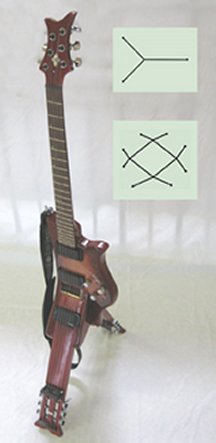At the heart of many of the world’s musical instruments is the same, simple component—a string stretched tight between two points. Plucked, bowed, or struck, each of an instrument’s strings creates ear-catching vibrations.

Now, mathematicians in Canada say that they have invented a family of music-making devices based on a network of three or more string segments—for instance, a Y-shaped string anchored at three endpoints. The extra segments supply exotic overtones that a single string doesn’t, say the researchers.
The first, and so far only, member of this new family of instruments is the tritare—rhymes with guitar—devised by mathematicians Samuel Gaudet and Claude Gauthier of the University of Moncton in New Brunswick. Resembling a guitar with two extra necks, the tritare hosts six Y-shaped strings. As in an ordinary guitar, each tritare string runs from a tuning peg along a fretted neck. However, the familiarity ends at an unanchored juncture point where the string branches. From there, one string segment runs along each of the two extra, unfretted necks.
Gaudet notes that a conventional, two-anchor musical-instrument string generates a fundamental sound frequency plus harmonics. Those frequencies are two, three, or other-integer multiples of the fundamental frequency.
The tritare generates not only those harmonic overtones but also nonharmonic ones, he says. Listeners typically hear such nonharmonic overtones from percussion instruments—for instance, bells or gongs—which vibrate in more-complicated patterns than simple strings do.
Depending on how each note on a tritare is played, the sound can include a few or many nonharmonic ingredients, Gaudet says. So, he adds, the instrument offers “a richer sound than does a classical stringed instrument.”
Richer yes, but not necessarily better, comments physicist and acoustics specialist Bernard Richardson of Cardiff University in Wales. “The branched string is really a simple analogue of the more complex structures found in things like plates and curved shells—bars, cymbals, bells, and gongs,” he notes. However, “to my ears [the tritare] just sounded like a badly out-of-tune instrument.”
“Sounds which are richer and less safe harmonically … provide inspiration and ways to musically express different things,” Gaudet contends. He and his colleague Sophie Léger, also of the University of Moncton, are slated to discuss the tritare and its design principles this week at a meeting of the Acoustical Society of America in Providence, R.I. Online sound clips of the tritare are available at http://www.acoustics.org/press/151st/Leger.html.
Given that so much music experimentation these days is done with computers, “the tritare may be one of the last new instruments to be invented relying entirely on novel physics without incorporating any computational element,” comments physicist and experimental–musical-instrument maker Benjamin W. Vigoda of the Massachusetts Institute of Technology.







